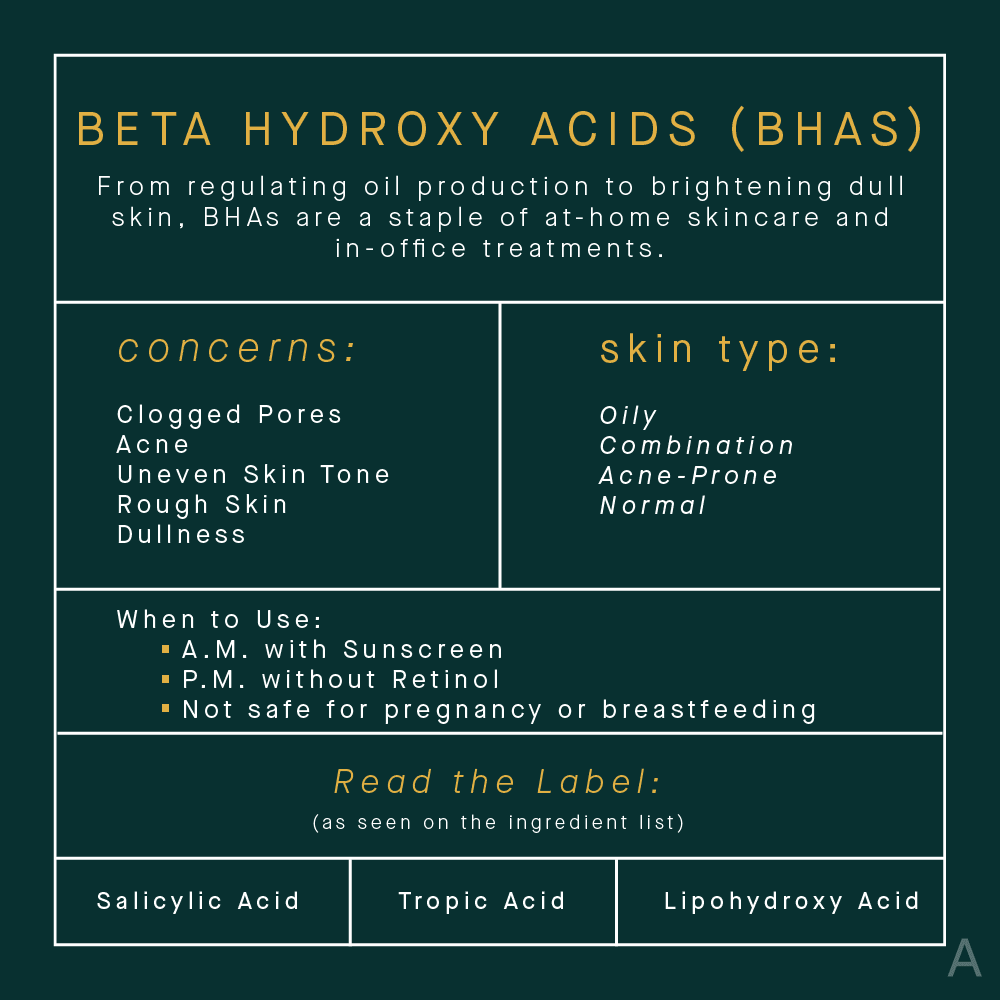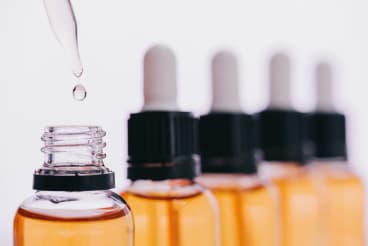 Acne Scar Treatment: Laser Resurfacing
Acne Scar Treatment: Laser ResurfacingRead The Label: All Your Beta Hydroxy Acid Questions Answered
Beta hydroxy acids (think: salicylic acid) are a key component of at-home and in-office acne treatments. The AEDITION asked the experts to break down the benefits of the multitasking ingredient.
Feel like you need a dictionary every time you look at the ingredient list of a beauty product? Still unsure of the difference between retinol and retinoids? What about the unique benefits of vitamins B, C, and E? Are alpha and beta hydroxy acids the same thing? The skincare aisle can be overwhelming, but you don’t need a PhD in cosmetic chemistry to navigate it. With expert help, The AEDITION is demystifying and simplifying the beauty industry — one label at a time.
Acids in skincare might sound scary. But, trust us, they may very well be exactly what your skin needs. Now that we’ve covered hyaluronic acid and alpha hydroxy acids (AHAs), it’s time to turn our attention to beta hydroxy acids (BHAs). From unclogging pores and regulating oil production to brightening dull skin, there is a reason BHAs are a staple of at-home skincare and in-office treatments. To find out more about the benefits, who it’s best for, and how to add it into your skincare routine, The AEDITION spoke with two board certified dermatologists.
What Are Beta Hydroxy Acids?
“Beta hydroxy acid is a type of acid that is oil-soluble and usually found in skincare products under the name ‘salicylic acid,’” explains board certified dermatologist Morgan Rabach, MD, of LM Medical in New York City. Once avaialble strictly in the dermatologist’s office within the compounds of a chemical peel, BHAs are now in many skincare products (at a lower dosage, of course) as a way to help treat and prevent acne, regulate sebum production, brighten pigmentation, and even skin tone and texture. Salicylic acid is one of three active ingredients (along with benzoyl peroxide and sulfur) approved by the United States Food and Drug Administration (FDA) for use in over-the-counter acne products.
The Benefits of BHAs in Skincare

“Because it is oil-soluble, BHAs go deeper into your pores and remove dead skin and sebum,” Dr. Rabach explains. As such, this ingredient — which is derived from willow bark, wintergreen, or sweet birch — is often recommended for those with oily and acne-prone skin who need a deeper level of exfoliation. In addition to clearing out the pores, salicylic acid has antibacterial properties that boost cell turnover while removing toxins and quelling inflammation. A poor skincare regimen, excess sebum production, inadequate hygiene, and more can result in dull, oily, pigmented, and, in some cases, acneic or breakout-prone skin. BHAs can gently remove this buildup, which clarifies the skin and allows for a better penetration of the skincare applied after it.
The Difference Between AHAs and BHAs
As you may recall from our guide to alpha hydroxy acids, the main distinction between AHAs and BHAs is their solubility. AHAs are water-soluble, while BHAs are oil-soluble. This difference allows for BHAs to better remove debris and toxins from the pores. “At home, AHAs and BHAs can be used as washes or in serums or lotions,” says Amy Spizuoco, DO, a board certified dermatologist and founder of True Dermatology in New York City. “In the office, dermatologists use them as chemical peels for treating acne, wrinkles, hyperpigmentation, and scarring.”
Often spoken about simultaneously, these two groups of acids are meant to serve as solutions to different cosmetic concerns. AHAs are beneficial for those looking to improve skin tone and texture and minimize the appearance of fine lines, and they can even be gentle enough for dry and sensitive skin. BHAs, meanwhile, best treat oily skin and acne concerns.
The Best Candidates for BHAs
Those with oily skin or those prone to breakouts see the most benefit from BHAs. Not just a teenage skin concern, acne can affect men and women alike into twenties, thirties, and forties. Unlike benzoyl peroxide, which is known for drying and stripping the skin (generally okay for hearty teenage skin, but too aggressive for adults), salicylic acid can be used in varying concentrations to treat and prevent acne, improve skin tone, lighten pigmentation, and more. “Many people start using it in their teenage years because it works great for acne,” Dr. Rabach says. “But it’s [also] good for those in their late twenties and early thirties as part of an anti-aging regimen.”
It should also be noted that even though acne is a common skin condition women deal with during pregnancy, salyicylic acid is not safe for women who are pregnant or breastfeeding.
How to Use BHAs
In OTC products, salicylic acid is available in concentrations ranging from 0.5 percent to 5 percent (there are also more potent prescription options). “Patients should consult with their dermatologist before using any acid, as some people may have skin that is too sensitive for certain AHAs and BHAs, especially at certain strengths,” Dr. Spizuoco cautions. “All too many times I've had patients needing to be treated for skin burns they induced from inappropriate use.”
If you find yourself lost in the skincare aisles looking for a BHA product, Dr. Rabach recommends reading the ingredient list carefully. “Usually, BHAs are in the form of ‘salicylic acid,’” she says, adding that you should look for a 1 to 2 percent dose in skincare and a 4 percent concentration for the scalp (to reduce flaking).
Available in OTC cleaners, toners, seums, body wash, and even hair products, there are an array of ways to incorporate salicylic acid into your morning and evening routine. “I recommend starting with a wash,” Dr. Spizuoco says. “This way, if it’s too strong, it won't have contact with the skin for too long.” Those ready for a deeper exfoliation can try a leave-on toner or serum once or twice a week. We like Paula’s Choice 2% BHA Liquid Exfoliant or The Inkey List Beta Hydroxy Acid Blemish + Blackhead Serum. Whatever you choose, don’t forget to be extra vigilant with your sunscreen usage while using it.
Like AHAs, retinoids, and vitamin C, BHAs can increase skin sensitivity — not just to the sun, but to other products and ingredients as well, Dr. Spizuoco says. “Until consistent and safe use of AHAs and BHAs is achieved, I recommend avoiding topical retinoids or retinols,” she shares. “This can be too strong and cause irritation and possible scarring on the skin.” If irritation does occur, she recommends applying a hyaluronic acid-based moisturizer to nourish and heal the skin.
The Takeaway
BHAs (read: salicylic acid) are a tried-and-true way to treat acne-prone skin and improve skin tone and texture. The oil-soluble chemical exfoliant gets deep into the pores to remove dirt and toxins, which makes it a popular compound in professional chemical peels, prescription-strength topicals, and OTC skincare alike. When considering adding a salicylic acid product to your routine, be sure to consult with your dermatologist to determine the concentration and format that is best for your skin.
All products featured are independently selected by our editors, however, AEDIT may receive a commission on items purchased through our links.
More Related Articles
Related Procedures

AI Plastic Surgeon™
powered by'Try on' aesthetic procedures and instantly visualize possible results with The AI Plastic Surgeon, our patented 3D aesthetic simulator.
